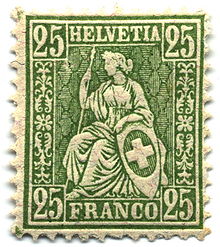Helvetia


Helvetia is the neo-Latin name for Switzerland, derived from the Helvetii tribe, and an allegorical female figure, which symbolizes Switzerland and the Confederation.
development
Helvetia was first mentioned in the 17th century as a female figure bundled from the cantonal allegories and a figure of identification for the Swiss Confederation: first in 1642 as a purely geographical figure in the Topographia Helvetiae by Matthäus Merian the Elder. Ä. , then 1672 as a stage figure to be understood politically in Johann Caspar Weissenbach's play Eydtgenossisch Contrafeth Auff- und Abnemmender Jungfrawen Helvetiae . He and several artists, who simultaneously depicted Helvetia, created a new figure of identification for the unity of the Swiss Confederation in times of division, especially through denominational disputes . This also testified to the increased self-confidence and the claim to a sovereign status after the federal places in the Peace of Westphalia (1648) had been granted "freedom and exemption " by the Holy Roman Empire.
With growing national awareness in the 19th century and the founding of the Swiss federal state in 1848, Helvetia gained importance as a national allegory. It appeared on coins and postage stamps and in political and patriotic depictions. So was z. For example, Helvetia was published between 1883 and 1896 as the forerunner of the Goldvrenelis .
The portrait of Helvetia can still be found on the coins for ½ , 1 and 2 francs (standing). Contrary to popular belief, the portrait on the coins of 5 , 10 and 20 centimes does not depict Helvetia, but Libertas .
"Helvetia" is still used as a country name on postage stamps and coins because none of the four national languages (German, French, Italian, Romansh) is preferred in Switzerland. For the same reason, the Latin country code CH was chosen, the abbreviation for Confoederatio Helvetica , Swiss Confederation.
In Irish (at Eilvéis), Greek ( Ελβετία, translit. Elvetia) and Romanian language (Elvetia) , the words "Helvetia" used as the country name for Switzerland, the Italian is as an adjective Elvetico (for Swiss use). Sciences about Switzerland are sometimes referred to as Helvetistics , for example by the Russian State University in Moscow.
Helvetia in art
At the Mittlere Brücke in Basel , on the Kleinbasel bank, is the sculpture “Helvetia on the journey”, which was made in 1980 by the Basel artist Bettina Eichin .
literature
- Gianni Haver : Dame à l'antique avec lance et bouclier: Helvetia et ses Déclinaisons , in: Gonseth M.-O./Knodel B./Laville Y./Mayor G. (eds.): Hors-champs. Eclats du patrimoine culturel immatériel, Musée d'ethnographie de Neuchâtel, 2013, pp. 274–282.
- Georg Kreis : Helvetia - through the ages. The story of a national figurehead. Verlag Neue Zürcher Zeitung, Zurich 1991, ISBN 3-85823-316-1 .
- Thomas Lau : «Step Brothers». Nation and confession in Switzerland. Böhlau-Verlag, Cologne a. a. 2008, ISBN 978-3-412-14906-2 , pp. 397-419, 455-459. (At the same time Habil script 2005)
- Thomas Maissen : From brave old confederates and sovereign virgins. On the dating and interpretation of the earliest «Helvetia» representations, in: Journal for Swiss Archeology and Art History 56 (1999), pp. 265–302.
- Thomas Maissen : The creation of Helvetia in the fine arts and in poetry , in: Stefan Hess / Tomas Lochman (eds.): Basilea. An example of urban representation in a female form, Basel 2001, pp. 84-101.
- Thomas Maissen : The Birth of the Republic. Understanding of the state and representation in the early modern Confederation (= historical semantics. Vol. 4). Vandenhoeck and Ruprecht, Göttingen 2006, ISBN 3-525-36706-6 , pp. 253-277 (also: Zurich, Univ., Habil.-Schr., 2001).
- Marie-Louise Schaller: Helvetia. Role models - ideal models . Booklet accompanying the exhibition in the Lucerne Central Library, May 15 - July 11, 1998, Lucerne 1998.
- Angela Stercken, unveiling of Helvetia. The language of state personification in the 19th century (= historical anthropology. Vol. 29). Reimer, Berlin 1998, ISBN 3-496-02641-3 (also: Basel, Univ., Diss., 1996).
Web links
- Georg circle: Helvetia (allegory). In: Historical Lexicon of Switzerland .

